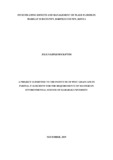INVESTIGATING EFFECTS AND MANAGEMENT OF FLASH FLOODS IN MARIGAT SUB-COUNTY, BARINGO COUNTY, KENYA
Abstract
Flash flood is a natural disaster that occurs due to the sudden onset of rainfall that causes runoff waters from high altitude areas to low altitude area. The purpose of the study was to investigate the effects and management of flash floods in Marigat Sub-County. The study used a descriptive research design. The target population of the study area was 24,893 households. Purposive sampling and stratified random sampling methods were used to select three locations affected by flash floods. These were Ilng‘arua, Ng‘ambo and Salabani. The locations had a population of 3168 households, from which a sample size of 355 was obtained. The study relied on both primary and secondary data. The questionnaires, key informants interview and observations were used to collect data. SPSS version 23 was used in the analysis of the data. This study adopted percolation theory in determining the effects and management of flash floods. The reliability of the instruments was through subjecting piloted data to Cronbach‘s analysis and the causes of flash floods was 0.70 alpha level, effects of flash floods was 0.73 alpha level and mitigations measures of flash floods was 0.71 alpha level proving a good instrument because any value less than 0.7 is not acceptable. The study found that; causes of flash floods were, Clearing of vegetation, climate change, topography, unsustainable farming practices, overstocking and siltation. 53% of the respondents inferred that, clearing vegetation is the main cause of flash floods. Further more, the study found that flash floods resulted in soil erosion. The recommended mitigation measures of flash floods in Marigat Sub-County were; cash transfers, humanitarian aids, building of bridges, and traditional early warning. The conclusions of the study was the local community were knowledgeable of the causes of flash floods but do not have resilience skills to predict and prevent flash floods. Additionally, the study held that flash floods have contributed to the increased poverty level in the study area. Lastly, the mitigation measures are limited, leading to frequent flash floods occurance with adverse effects. Recommendations are policy review and their implementations. The findings and recommedations of the study are beneficial to Baringo County and the national Kenyan government for management of flash floods and the achievement of sustainable development goals which directly benefits the residents of Marigat sub-county.

